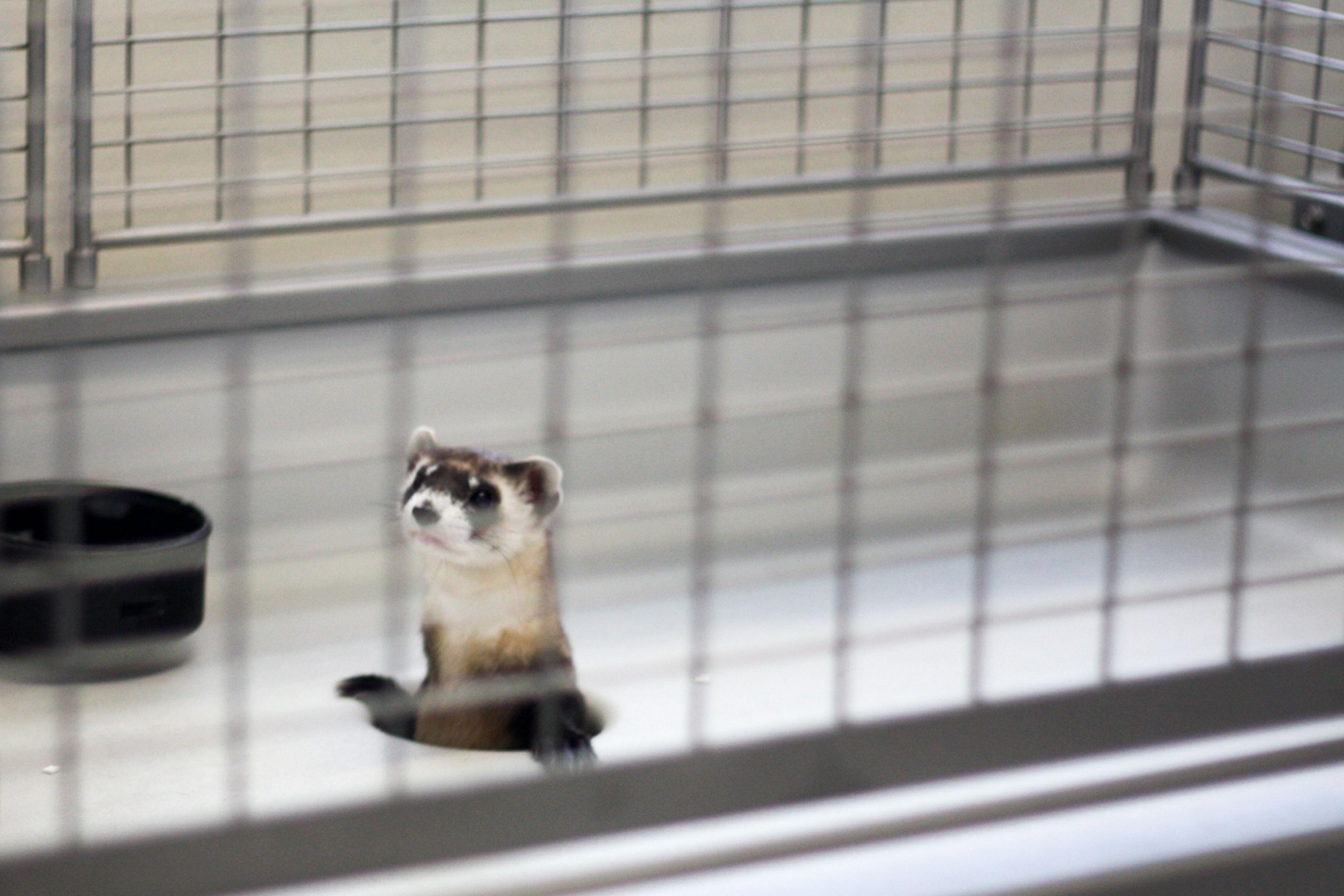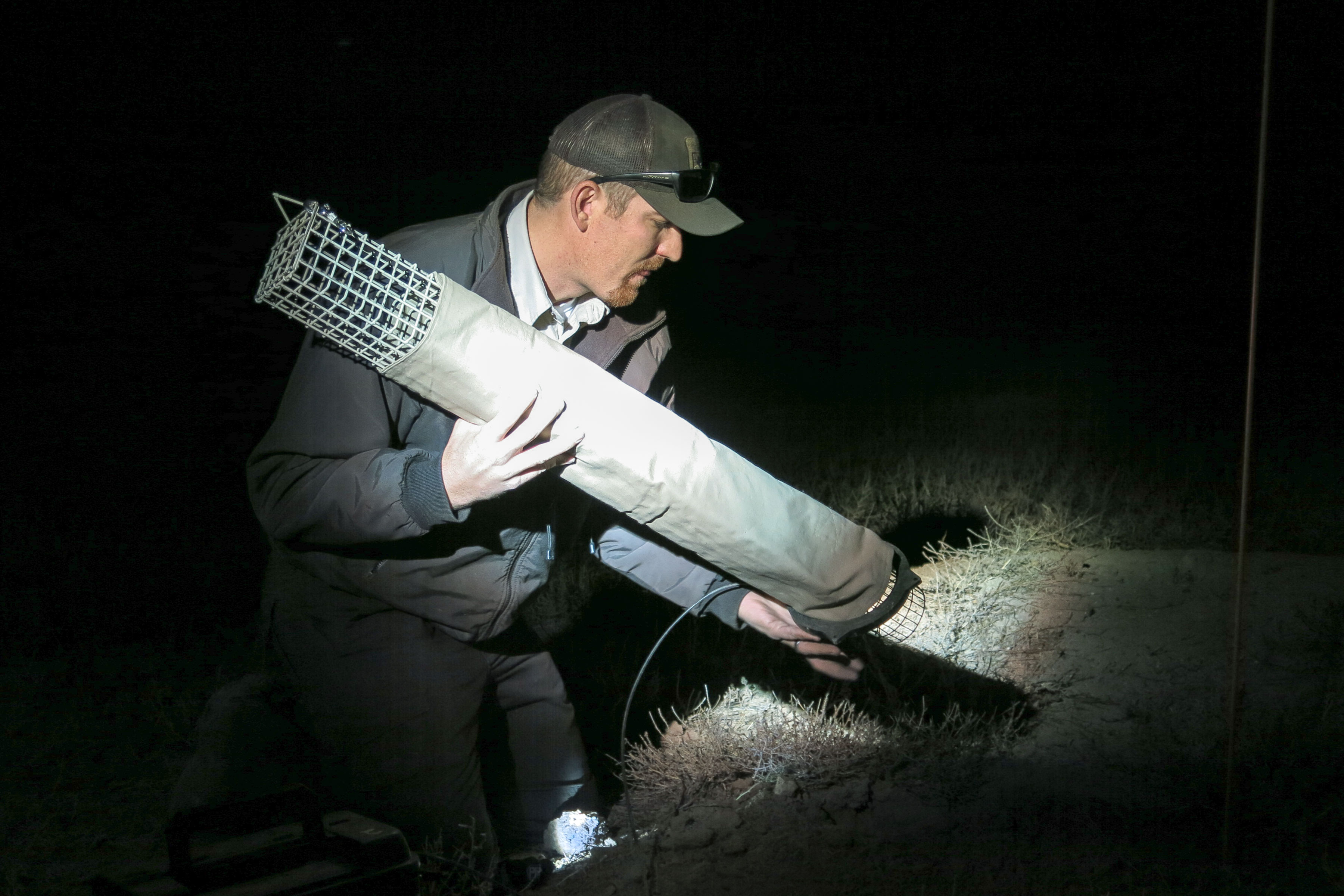

Inside a nondescript building north of Fort Collins, U.S. Fish and Wildlife biologist Robyn Bortner wends her way through a maze of metal cages. Each one has a name.
There’s The Fonz, Captain Crunch. And Mrs. Doubtfire.
“You’ll notice he’s a male,” Bortner says. “Someone was feeling very clever that year.”
She opens a dark box on the floor that holds a female ferret to show what’s going on inside: several young ferrets, called kits, fidget around.
“Usually she has some choice words about us checking in on her,” Bortner says, as the ferret barks. That’s because the mother ferret just woke up. In the wild, these animals sleep underground about 20 hours a day. At night, they hunt and eat prairie dogs, taking over their underground burrows.

Three decades ago black-footed ferrets were almost extinct. But this captive breeding program in Northern Colorado at the National Black-Footed Ferret Conservation Center is showing promise bringing the animal back from oblivion. Most black-footed ferrets that end up in nature began their lives here.
Learning To Live The Ferret Life
How does a captive-bred ferret gain critical survival skills?
“What you’re seeing here is kind of a boot camp, really,” says another wildlife biologist, John Hughes, as he walks outside past one of 40 tall pens. There are mesh covers on top. Walls go 6 feet deep underground to prevent escapes. At three months, young ferrets enter one of these pens for what’s called preconditioning. None are visible on this particular day, which Hughes says is a good thing.
“As we say out here, they’re acting like ferrets,” meaning they nap during the day and hunt at night. Ferrets here need two live prairie dog kills before they’re released into the wild. Last night biologists released the prairie dogs into several of the pens.

A ferret bounces over to the fence to greet us and Hughes stops to compare notes with a colleague, Tyler Tretten, about how this particular ferret — a resident at the facility for a month — fared at meal time.
From the looks of things, “He obviously appears to be wanting us to bring him food rather than killing his own,” Hughes says, and isn’t equipped to release into the wild. “If he’s been out here this long, he’s not all the sudden going to have an epiphany.”
The animal will likely live the rest of his days inside a live zoo or museum display.
Taking A Tally Of Ferrets
Outside of Denver, the Rocky Mountain Arsenal Wildlife Refuge plays a key part in efforts to save the black-footed ferret. The refuge spends about $6,000 to give each of the creatures a safe haven to grow their numbers, be counted in a census, and inoculated against a potentially catastrophic plague.
So far, reintroduction efforts here have gone much better than expected. Biologists had predicted a 30-to-40 percent survival rate but preliminary data suggests it’s better than 70 percent, says David Lukas, who manages the wildlife refuge.
“We’re currently unable to explain why we’ve had such great success out here. That’s one of the questions that we’re going to have to work together to figure out because that’s an important question for the long-term recovery program,” he says.

Last fall, ferret survey crews set out in a truck and on ATVs, bouncing over rutted dirt roads on the back end of the arsenal. Around them, the grasslands were a vast spreading darkness, ringed by the glittering lights of the suburbs. The crews swept spotlights across the dry grass, looking for the emerald green shine of ferret eyes.
“It’s really just a needle-in-a-haystack game. You’re driving by at the exact moment that a ferret has poked his head up out of the ground and you capture it with your spotlight,” Likas says, before spotting a ferret — in the talons of an owl.
This cruel reality of nature isn’t regarded as a setback, Lucas says, because restoring ferrets should improve the whole ecosystem at the refuge and beyond. Which brings this story back around to prairie dogs.
“I believe, and I hope that we will see, that by bringing this top predator back in, we'll see healthier prairie dogs communities, we're going to see a healthier prairie dog ecosystem out here,” he says.

Prairie dogs are under major threat from development, and a disease called sylvatic plague that has blown across the rodent population of the West. It’s very difficult to react to and it is very catastrophic. If the plague arrives at the Rocky Mountain Arsenal refuge and all the prairie dogs die, this work to bring back ferrets could end in a quick catastrophe. That’s why refuge workers have been trying to inoculate as many prairie dogs as possible — scattering peanut butter-flavored vaccine pellets across thousands of acres.
When you start looking at the landscape, that’s a lot of work. And a lot of vaccine.
Back in 2006, there were more than about 1,500 black-footed ferrets living in the wild, wildlife experts say. Plague carried by prairie dogs brought that number down to about 300.
Back outside of Fort Collins, Tretten and Hughes move to another pen to check in on a ferret named Plantain. She was also given a live prairie dog the previous night, and the pair take a look into the ferret’s underground den burrow by pulling up some insulation designed to mimic the ceiling of the den.
“She got it last night,” says Tretten. “And she’ll just munch on it the next few days.”
This is the ferret’s second confirmed kill. That means Plantain will get released to one of two dozen sites this fall. It may even be one of the most successful sites, the Rocky Mountain Arsenal Wildlife Refuge.









